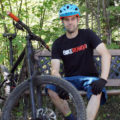When I first heard of composite flat pedals, I was skeptical that they would be tough enough for MTB. After riding several sets, including the updated Race Face Chester pedals, I’m convinced you’d have to do something severe to catastrophically damage a composite pedal body. They are tough enough, and they’re lightweight and inexpensive!
For complete details on the updated Chester pedals, check out Bikerumor’s launch article from last summer. In short, the Chesters are Nylon composite pedals that come in small or large size options. Their updated design aims to provide better traction than the older model, and a flatter feel without a hump over the axle. I’ve been riding the Chesters for several weeks now, and I’m pretty pleased with their platform shape, grip, and durability.
Race Face Chester Pedals – Key Specs:

The new Chester pedal bodies are made from a durable Nylon composite. The body shape was redesigned for “a sleeker look and improved feel” over the outgoing version, and I’d agree they look more streamlined.
Based on my preference for larger-bodied pedals I opted to test the large Chesters. They measure 115mm long, 110mm wide and 16mm thick. Race Face really wanted to eliminate the hump over the axle the older Chester pedals had. While a minor hump is still visible on each end of the axle, it’s been flattened right down in the middle.

These pedals feature 11 pins per side – Nine replaceable metal pins and two molded pins. Race Face says they improved the pin placement over the last Chester pedal, to offer better grip and easy foot repositioning. The new pedal’s pins are definitely spread out over a larger area than the old version.
Rotating on a chromoly spindle, the Chester’s internals are serviceable and rebuildable. Race Face also eliminated the wrench flats from the older model’s spindles to give the new Chesters a reduced Q-Factor.

The large Chester pedals are pretty lightweight at 358g, especially given their generous platform. Race Face claims 355g, which is close enough for me to call honest!
Ride Impressions – Shape and Feel:

I’ve been riding the Chesters for several weeks now, first on the Devinci Troy I recently reviewed and later on my own Knolly Chilcotin.
I wear size 9.5 shoes, and I find the large Chester pedals’ width is easily adequate. The only thing I prefer about more square shaped pedals is they offer more side-to-side support when your foot bounces out of position. With the Chesters, you’re perfectly well supported when your foot is planted correctly, but their tapered shape offers less room for error if your foot shifts outwards.
However, the Chester’s shape provides a ton of platform front-to-back. This pedal feels very supportive and comfortable under hard pedalling, and they’re definitely not going to give you the ‘crow’s foot’ feeling. At 16mm they’re not the slimmest pedal out there, but only by a few millimeters. The Chesters keep your feet pretty close to the spindles and don’t feel blocky or thick.

At Crankworx, Race Face’s sales rep told me one priority with the Chester’s updated design was to minimize the old version’s hump over the axle. A look at the pedal shows there is now only a slight bulge at either end of the axle, and the middle is dead flat. I’d say their slimming accomplished the goal; I don’t find the slight humps noticeable at all.
The metal pins on the Chesters are longer than the molded pins, and they sit higher than the pedal body’s middle section. This allows your feet to sink in and gives the Chesters a slightly concave feel.
Traction:

I rode two different pairs of shoes with the Chesters; Crankbrothers Stamp Trails and Endura MT500s. I started out riding the Stamp Trail shoes and found I had good grip, but nothing I’d call super grabby. It wasn’t hard to adjust my foot position, and my foot did get bounced off the pedal once or twice on rough trails.

The Chesters seem to grip the Endura MT500 shoes more forcefully. These shoes immediately felt more solidly stuck to the pedals than the Crankbrothers, and it takes a bit more effort to re-position them. The MT500’s triangular middle lugs (vs the rectangular Stamp Trail tread pattern) definitely stick better on the Chester’s pins. I preferred the grippier feel of these shoes, especially on rough trails where my feet stayed locked in position better.
Durability:

Due to my Knolly’s low bottom bracket, the Chesters have suffered their fair share of pedal strikes! Despite this, the worst damage I have inflicted was flattening one of the molded pins on one pedal. Otherwise, both have nothing more to show than small scratches on the outside edges. Two of the metal pins appear to have taken hits, but all of them are still straight and fully intact. Should you mangle or break one, the Chesters’ bottom-loading pins should remain easy to remove.
I haven’t been beating on the Chesters for too long but they have been put through wet and muddy fall conditions. So far I’ve had no mechanical issues with the internals, and the spindles are still straight.
Race Face’s updated Chester pedals retail for $55, and are available in eight different colors.

